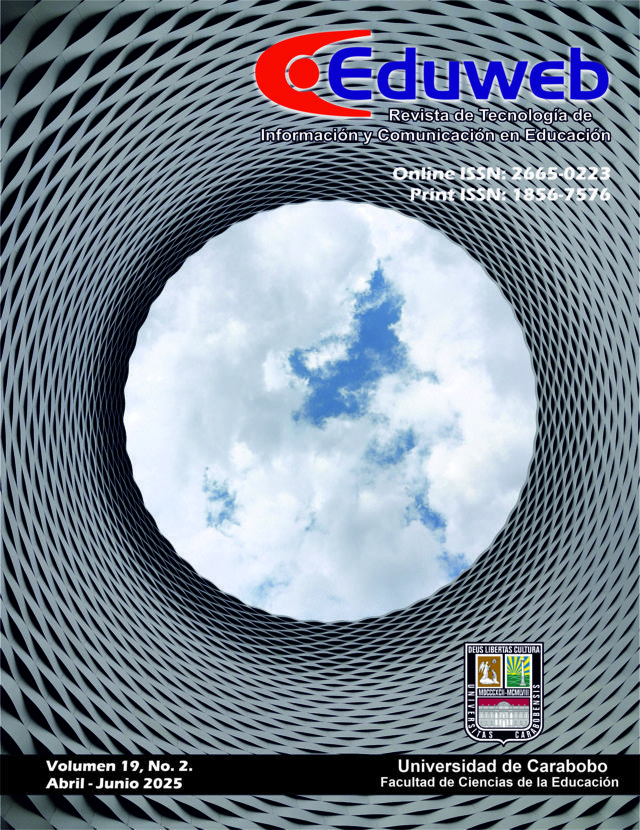El uso de las tecnologías educativas para garantizar la continuidad de la educación preescolar y primaria
DOI:
https://doi.org/10.46502/issn.1856-7576/2025.19.02.12Palabras clave:
adaptación, educación primaria, gamificación, plataformas interactivas, tecnologías educativasResumen
La importancia de la investigación sobre el uso de las tecnologías educativas para garantizar la continuidad de la educación preescolar y primaria viene determinada por la creciente necesidad de crear condiciones eficaces para una transición sin problemas de los niños de la educación preescolar a la primaria. La falta de programas de adaptación y soluciones tecnológicas conduce a una disminución del nivel de motivación para el aprendizaje de los niños. Las tecnologías modernas, como las plataformas interactivas, la gamificación y el aprendizaje adaptativo, pueden mejorar significativamente la calidad de esta transición. El objetivo del estudio es evaluar el impacto de las tecnologías educativas en el nivel de rendimiento de los niños en el período de transición entre la educación preescolar y la primaria. La investigación empleó los siguientes métodos: cuestionarios, pruebas y aplicación experimental de plataformas interactivas en instituciones educativas. Los resultados del estudio mostraron que el 87% de los niños demostró un alto nivel de adaptación después de la implementación de tecnologías educativas, en comparación con el 65% en el grupo control (GC). El rendimiento aumentó en un 18% y el nivel de ansiedad disminuyó en un 25%. Las perspectivas de investigación incluyen un análisis del impacto del uso a largo plazo de estas tecnologías en el rendimiento académico de los niños y la adaptación social.
Citas
Abakirova, А., & Кarasartova, J. (2024). Pedagogical technologies in education and upbringing of children for future elementary school teachers. Bulletin of Issyk-Kul University, 57, 260-266. https://doi.org/10.69722/1694-8211-2024-57-260-266
Alzahrani, A. (2023). Impact of digital practices on pre and primary school children’s grades. International Journal of Science and Research (IJSR), 12(6), 16-25. https://doi.org/10.21275/sr23530081430
Atil lemoualdi, A. (2021). Medias and electronic medias as one of the factors affecting pre-school education. Milev Journal of Research and Studies, 7(2), 104-117. https://doi.org/10.58205/mjrs.v7i2.900
Borges, F. F., Teixeira, J. A., & Acedo, S. O. (2020). Uso de repositorios de recursos educacionales abiertos en las prácticas pedagógicas: una revisión sistemática. Revista Latinoamericana de Tecnología Educativa – RELATEC, 19(2), 115-133. https://doi.org/10.17398/1695-288x.19.2.115
Elshafey, D., Gana, A., Manar, A., Manar, K., Mariem, G., Menna, A., & Menna Eman, M. (2024). Modern technology in teaching science. Journal of Humanities and Social Sciences, 3, 163-174. https://doi.org/10.21608/aash.2024.376809
Eyyubov, R., & Sakhavat., S. (2020). The use of computer technology in primary school. Scientific Work, 60(11), 12-15. https://doi.org/10.36719/2663-4619/60/12-15
Hayat, M., & Iqbal, A. (2024). Teachers capacity and students perception about technology: A case in modern academia. Kardan Journal of Social Sciences and Humanities, 7(1), 34-53. http://dx.doi.org/10.31841/KJSSH-7.1-2024-71
Hoon, L., & Shaharuddin, S. (2019). Learning effectiveness of 3D hologram animation on primary school learners. Journal of Visual Art and Design, 11(2), 93-104. https://doi.org/10.5614/j.vad.2019.11.2.2
Kliziene, I., Taujanskiene, G., Augustinienė, A., Simonaitienė, B., & Cibulskas, G. (2021). The impact of the virtual learning platform EDUKA on the academic performance of primary school children. Sustainability, 13(4), 2268. https://doi.org/10.3390/su13042268
Larionova, T. V., & Filippenko, L. V. (2023). Information and communications technology in the educational process of primary school: Impact on schoolchildren. Tambov University Review. Series: Humanities, 28(1), 7-23. https://doi.org/10.20310/1810-0201-2023-28-1-7-23
Moya, A. V., Morancho, M. V., & Garrido, L. C. (2020). The educational use of Social Networks Sites: A comparative analysis between the Spanish and English production. Digital Education Review, 37, 304-322. https://doi.org/10.1344/DER.2020.37.304-322
Oluwayimika, K. R., & Eberechukwu, A. S. (2022). Impact of modern technology on undergraduate students for teaching and learning in tertiary institutions. American Journal of Creative Education, 5(2), 42-51. https://doi.org/10.55284/ajce.v5i2.779
Price, L. L. A., Dahlmann-Noor, A., & Khazova, M. (2024). Daylight and electric lighting in primary and secondary school classrooms in the UK – An observational study. International Journal of Environmental Research and Public Health, 21(7), 942. https://doi.org/10.3390/ijerph21070942
Qu, L. (2023). Pre-service primary school teachers’ view of nature of science helps decision-making on socio-scientific issues. Science Insights Education Frontiers, 14(2), 2051-2054. https://doi.org/10.15354/sief.23.co031
Quiles-Rodríguez, J., Mateo-Sanz, J., & Palau, R. (2024). How does coloured lighting influence the affective processes of pupils? Interaction Design and Architecture(s), 60(60), 103-121. https://doi.org/10.55612/s-5002-060-004
Radul, O. (2022). Primary school teacher in modern world. Academic Notes Series Pedagogical Science, 1(204), 44-48. https://doi.org/10.36550/2415-7988-2022-1-205-44-48
Ray, S. (2019). Impact of pre-primary education on academic achievement of elementary school students in basic school subjects. International Journal of Early Years Education, 32(2), 1-19. https://acortar.link/ptXklZ
Recalde, J., Palau, R., Neus, L., & Gallon, R. (2020). Developments for smart classrooms: School perspectives and needs, International Journal of Mobile and Blended Learning, 12(4), 1-17. https://doi.org/10.4018/IJMBL.2020100103
Romanyuk, S., Maftyn, L., Iliichuk, L., Vasylyk, M., & Tarangul, L. (2023). The use of modern technologies to enhance the quality of teaching at higher education institutions. Amazonia Investiga, 12(68), 224-235. https://doi.org/10.34069/AI/2023.68.08.21
Shuima, M., Perinpasingam, T., & Mariyam, A. (2024). Teachers’ perceptions of the impacts of technology on key stage 2 students in Fuvahmulah city, Maldives. Asia-Pacific Journal of Futures in Education and Society, 3(3), 107-121. https://doi.org/10.58946/apjfes-3.3.P6
Shvardak, M. (2023). Digital interactive technologies in educational process of primary school. Scientific Journal of the Khortytsya National Academy. Series: Pedagogy. Social work, 1(8), 39-48. https://doi.org/10.51706/2707-3076-2023-8-3
Yan, Z. (2021). Preliminary research on the integration of modern educational technology and primary school teaching. Advances in Vocational and Technical Education, 3(2), 1-5. https://doi.org/10.23977/AVTE.2021.030201
Yasmin, S., & Rumi, M. (2020). Impact of pre-primary education on children in Bangladesh: A study on government primary schools in Sylhet city. American Journal of Educational Research, 8(5), 251-258. http://pubs.sciepub.com/education/8/5/4
Yeşilyurt, M. (2023). Meta-analysis of the effect of technologies on primary school. Basic training, 3(2), 26-41. https://doi.org/10.52105/temelegitim.3.2.3
Yizengaw, J., & Nigussie, A. (2023). Availability and utilization of educational technology in primary schools of Ethiopia. Journal of Educational Technology Development and Exchange (JETDE), 16(2), 20-39. https://doi.org/10.18785/jetde.1602.02
Zakieva, R., Shirieva, Y. (2019). Problems of studying and implementing innovative lighting technologies in vocational education. Bulletin of Nizhnevartovsk State University, 4, 8-15. https://doi.org/10.36906/2311-4444/19-4/02
Descargas
Publicado
Cómo citar
Número
Sección
Licencia
Derechos de autor 2025 Liudmyla Berezovska, Iryna Saraieva, Tetiana Britskan, Solomiia Ushnevych, Oksana Tytun

Esta obra está bajo una licencia internacional Creative Commons Atribución 4.0.















